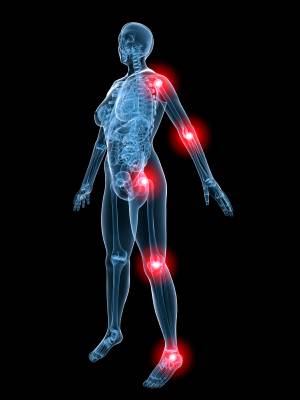A technique called occipital nerve stimulation (ONS) lessens pain in fibromyalgia patients by activating intrinsic nervous system pain inhibitory pathways, a study shows.
The occipital nerves are two pairs of nerves that stem from near the second and third vertebrae of the neck and provide sensation to the back of the head up to the top, and behind the ears.
ONS is a technique that uses small electrodes implanted under the skin and sends electrical impulses that travel through the occipital nerves inhibiting pain sensation.
The approach has been proposed as a potential strategy to decrease fibromyalgia-related pain, but the neural mechanisms underlying the therapy’s regulation of pain remain poorly understood.
In the study, “The effect of occipital nerve field stimulation on the descending pain pathway in patients with fibromyalgia: a water PET and EEG imaging study,” published in the journal BMC Neurology, researchers investigated how ONS may inhibit pain in fibromyalgia.
They analyzed seven fibromyalgia patients, all females at a mean age of 42, who had electrodes implanted under the skin. Participants were recruited from a large, double blind, placebo-controlled Phase 2 clinical trial (NCT00917176) assessing the effectiveness of ONS in fibromyalgia.
Patients were stimulated at a sub-sensory threshold for two weeks, in which they underwent imaging by positron emission tomography (PET) during the “on” (active stimulation) and “off” (stimulating device turned off) periods. Additionally, they underwent measurements of brain activity, via a technique called electroencephalogram (EEG), during the same periods.
The primary outcome parameter for determining the effectiveness of the treatment were changes in Fibromyalgia Impact Questionnaire scores (FIQ), which assessed the overall impact of fibromyalgia-related symptoms on a patient’s quality of life.
FIQ’s maximum score is 100, where higher scores are indicative of higher disease burden.
The questionnaire was filled out at the beginning of the study, and then at four, 12, 18 and 24 weeks after treatment.
Secondary outcomes included the Pain Vigilance and Awareness Questionnaire (PVAQ), which assesses a patient’s concern with pain and pain-related fear; Pain Catastrophizing Scale (PCS); and Numeric Rating Scales (NRS), a parameter of quality of life, where higher scores indicate a higher quality of life while living with pain. NRS was used to assess patients’ symptom relief and satisfaction with the treatment.
All these parameters were evaluated in the same periods as the primary outcome.
Results showed that the FIQ scores were reduced by 25.84%, meaning that ONS lessened patients’ pain burden.
The same was seen with the secondary outcomes, with a decrease of 34.51% in the PVAQ , meaning patients were less worried about pain and free from pain-related fear. In fact, researchers reported a drop of 30.71% in fibromyalgia-related pain, a 35.75% reduction in bone and joint pain, and 30.52% less non-specified pain.
Patients also reported a 59.24% overall improvement in quality of life.
Compared with the “off” period, ONS stimulation activated several regions in the brain, including two called the bilateral anterior cingulate cortex and the parahippocampal area. These areas are part of the descending pain pathway — similar to pathways that communicate pain from the body into the brain (ascending pain pathways), descending pain pathways communicate signals to inhibit pain from the brain to the body.
These results were detected with both the PET scans and the EEG.
Additionally, ONS stimulation activated regions in the lateral pain pathway, shown by PET scans.
“PET shows that ONS exerts its effect via activation of the descending pain inhibitory pathway and the lateral pain pathway in fibromyalgia, while EEG shows activation of those cortical areas that could be responsible for descending inhibition system recruitment,” the researchers wrote.
“Further functional imaging studies should be performed to evaluate these findings on a larger sample size and with other neuromodulation techniques,” they concluded.

